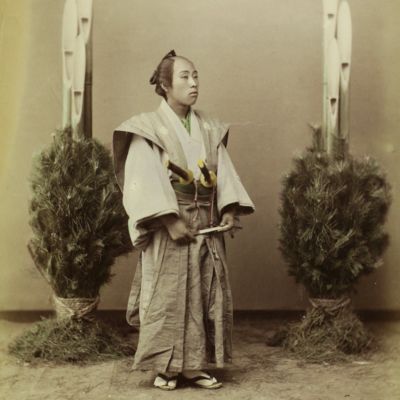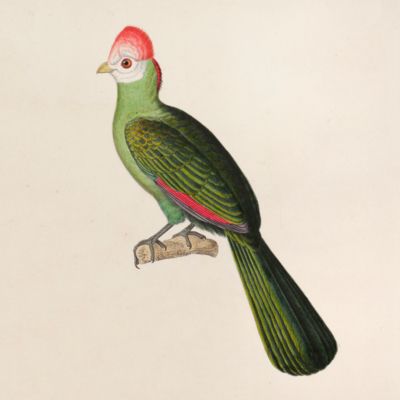[Samurai]
Original photograph heightened with delicate watercolours.
Japan, ca. 1890. Albumen print (26.5 x 21.2 cm), with additional colouring.
A nice, large photo, captioned B 1159 Samurai Waking Style. This photograph shows a studio portrait of a samurai, full-length, standing between two potted conifers and bamboo. “Samurai were the hereditary military nobility and officer caste of medieval and early-modern Japan from the 12th century to their abolition in the 1870s. They were the well-paid retainers of the daimyo (the great feudal landholders). They had high prestige and special privileges such as wearing two swords. They cultivated the bushido codes of martial virtues, indifference to pain, and unflinching loyalty, engaging in many local battles. During the peaceful Edo era (1603 to 1868) they became the stewards and chamberlains of the daimyo estates, gaining managerial experience and education. In the 1870s they were 5% of the population. The Meiji Revolution ended their feudal roles and they moved into professional and entrepreneurial roles. Their memory and weaponry remain prominent in Japanese popular culture.” (Wikipedia). The word ‘waking’ is peculiar, perhaps watching, or warding is meant. The same photo, framed, is, according to their website, present in the Library of Congress. Weak, pencilled annotation on verso. Mildly creased, more so towards the margins; print strong. A very attractive item.


![image for Giant snake [Plate 101 of Seba's <em>Locupletissimi rerum naturalium thesauri accurata descriptio</em> Volume II].](https://www.schierenberg.nl/media/cache/product_thumb/76716/76716_x.jpg)
![image for Astronomische Untersuchungen. Erster Band [AND] Zweiter Band. [Complete].](https://www.schierenberg.nl/media/cache/product_thumb/63633/63633.jpg)
![image for Histoire générale des voyages, ou nouvelle collection des toutes les relations de voyages par mer et par terre, qui ont été publiées jusq'à présent dans les différentes langues de toutes les nations connus: ... Tome dix-septième. Histoire générale des voyages, depuis le commencement du XVme siècle, dix-septième partie. Livre septième. Vies des gouverneurs généraux, avec l'abregé de l'histoire des etablissemens Hollandois aux Indes Orientales [AND] Histoire naturelle des Indes Orientales.](https://www.schierenberg.nl/media/cache/product_thumb/62296/62296.jpg)

![image for Opuscula 1924-1950. [Works; collection of offprints]](https://www.schierenberg.nl/media/cache/product_thumb/68211/68211.jpg)


